warning MAZDA MODEL MAZDASPEED 3 2009 (in English) Manual PDF
[x] Cancel search | Manufacturer: MAZDA, Model Year: 2009, Model line: MODEL MAZDASPEED 3, Model: MAZDA MODEL MAZDASPEED 3 2009Pages: 412, PDF Size: 6.18 MB
Page 129 of 412
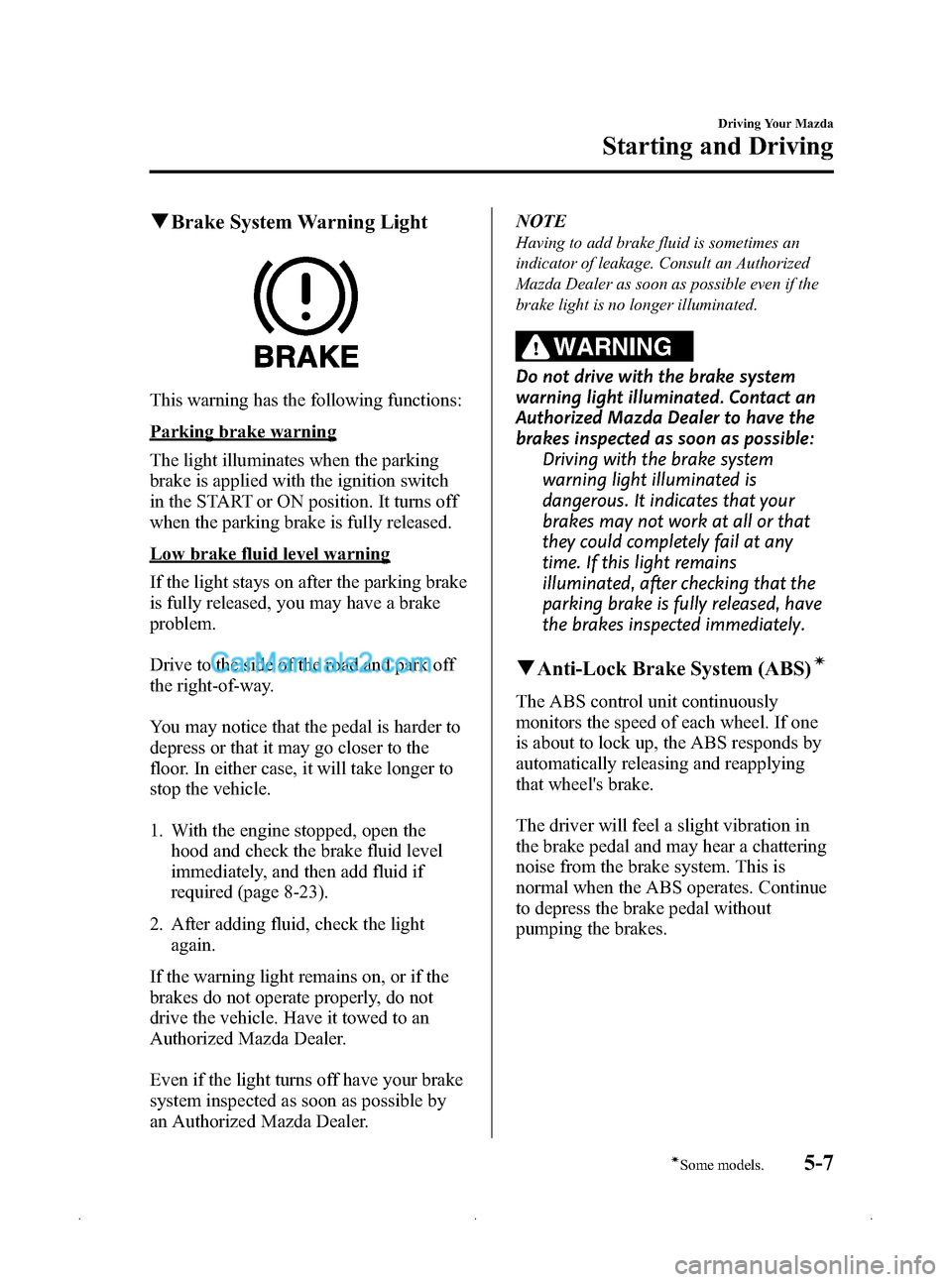
Black plate (129,1)
qBrake System Warning Light
This warning has the following functions:
Parking brake warning
The light illuminates when the parking
brake is applied with the ignition switch
in the START or ON position. It turns off
when the parking brake is fully released.
Low brake fluid level warning
If the light stays on after the parking brake
is fully released, you may have a brake
problem.
Drive to the side of the road and park off
the right-of-way.
You may notice that the pedal is harder to
depress or that it may go closer to the
floor. In either case, it will take longer to
stop the vehicle.
1. With the engine stopped, open the
hood and check the brake fluid level
immediately, and then add fluid if
required (page 8-23).
2. After adding fluid, check the light again.
If the warning light remains on, or if the
brakes do not operate properly, do not
drive the vehicle. Have it towed to an
Authorized Mazda Dealer.
Even if the light turns off have your brake
system inspected as soon as possible by
an Authorized Mazda Dealer. NOTE
Having to add brake fluid is sometimes an
indicator of leakage. Consult an Authorized
Mazda Dealer as soon as possible even if the
brake light is no longer illuminated.
WARNING
Do not drive with the brake system
warning light illuminated. Contact an
Authorized Mazda Dealer to have the
brakes inspected as soon as possible:
Driving with the brake system
warning light illuminated is
dangerous. It indicates that your
brakes may not work at all or that
they could completely fail at any
time. If this light remains
illuminated, after checking that the
parking brake is fully released, have
the brakes inspected immediately.
qAnti-Lock Brake System (ABS)í
The ABS control unit continuously
monitors the speed of each wheel. If one
is about to lock up, the ABS responds by
automatically releasing and reapplying
that wheel's brake.
The driver will feel a slight vibration in
the brake pedal and may hear a chattering
noise from the brake system. This is
normal when the ABS operates. Continue
to depress the brake pedal without
pumping the brakes.
Driving Your Mazda
Starting and Driving
5-7íSome models.
Mazda3_8Z87-EA-08F_Edition1 Page129
Monday, May 19 2008 9:57 AM
Form No.8Z87-EA-08F
Page 130 of 412
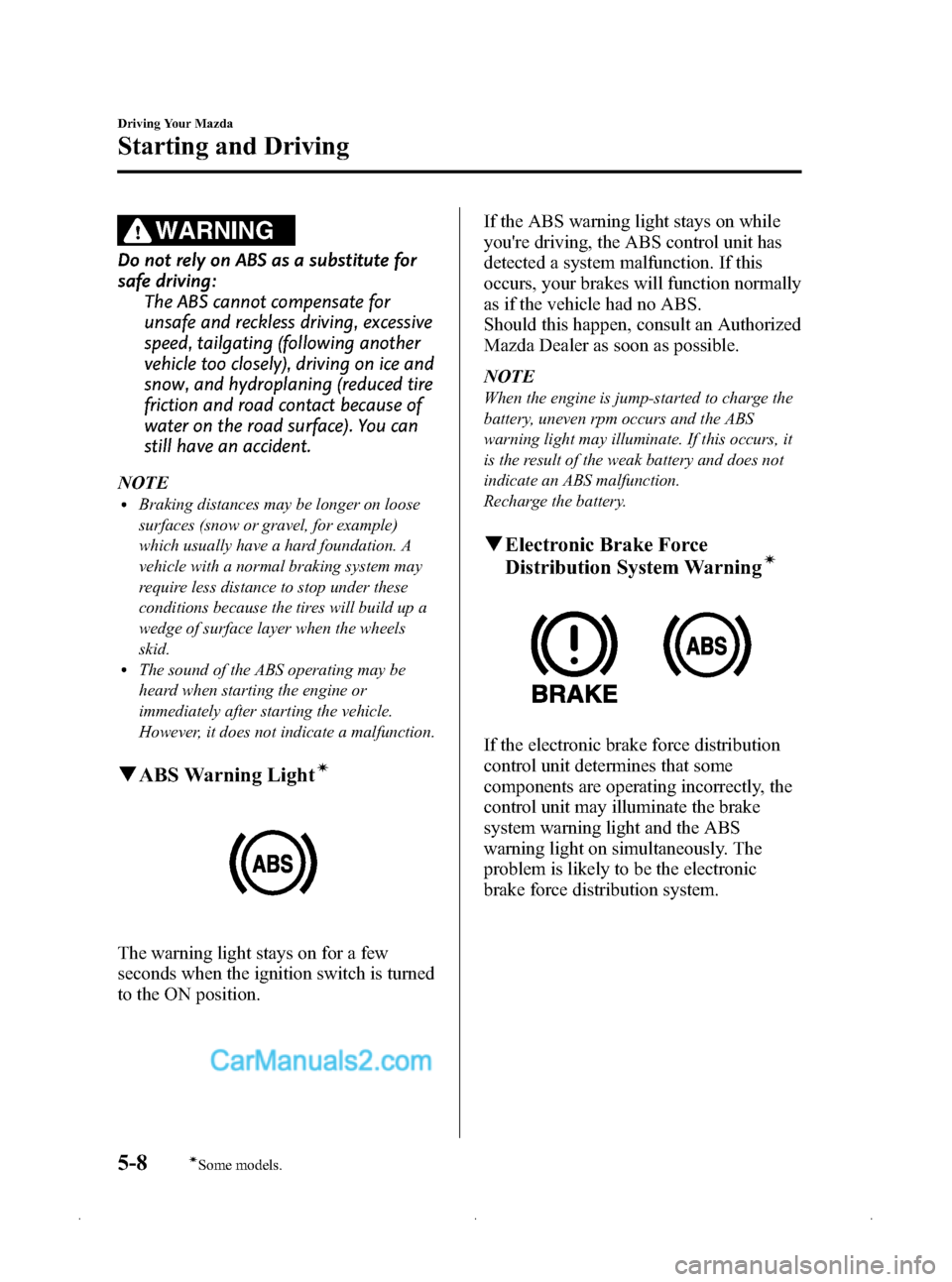
Black plate (130,1)
WARNING
Do not rely on ABS as a substitute for
safe driving:The ABS cannot compensate for
unsafe and reckless driving, excessive
speed, tailgating (following another
vehicle too closely), driving on ice and
snow, and hydroplaning (reduced tire
friction and road contact because of
water on the road surface). You can
still have an accident.
NOTE
lBraking distances may be longer on loose
surfaces (snow or gravel, for example)
which usually have a hard foundation. A
vehicle with a normal braking system may
require less distance to stop under these
conditions because the tires will build up a
wedge of surface layer when the wheels
skid.
lThe sound of the ABS operating may be
heard when starting the engine or
immediately after starting the vehicle.
However, it does not indicate a malfunction.
q ABS Warning Lightí
The warning light stays on for a few
seconds when the ignition switch is turned
to the ON position. If the ABS warning light stays on while
you're driving, the ABS control unit has
detected a system malfunction. If this
occurs, your brakes will function normally
as if the vehicle had no ABS.
Should this happen, consult an Authorized
Mazda Dealer as soon as possible.
NOTE
When the engine is jump-started to charge the
battery, uneven rpm occurs and the ABS
warning light may illuminate. If this occurs, it
is the result of the weak battery and does not
indicate an ABS malfunction.
Recharge the battery.
q
Electronic Brake Force
Distribution System Warningí
If the electronic brake force distribution
control unit determines that some
components are operating incorrectly, the
control unit may illuminate the brake
system warning light and the ABS
warning light on simultaneously. The
problem is likely to be the electronic
brake force distribution system.
5-8
Driving Your Mazda
íSome models.
Starting and Driving
Mazda3_8Z87-EA-08F_Edition1 Page130
Monday, May 19 2008 9:57 AM
Form No.8Z87-EA-08F
Page 131 of 412
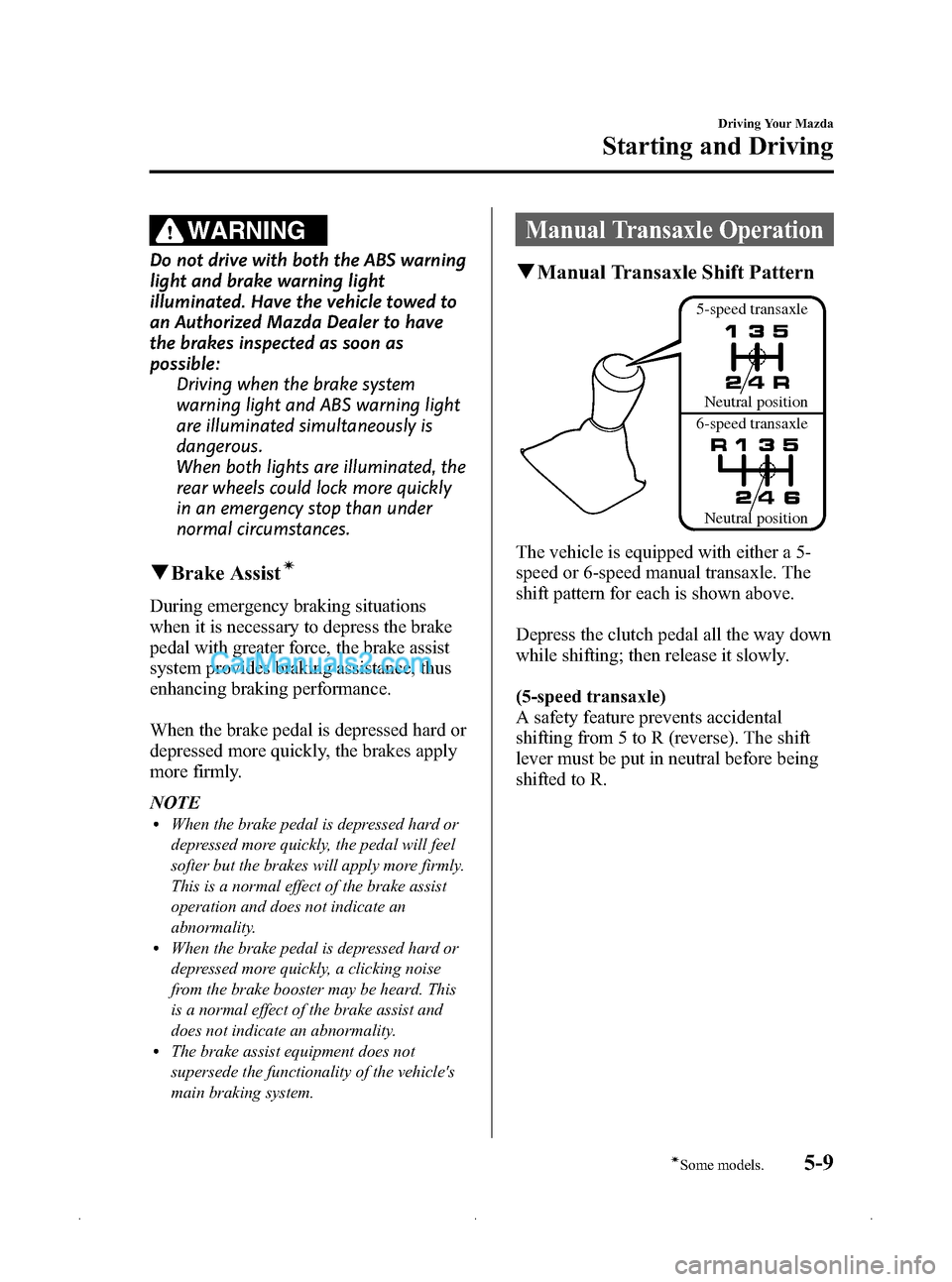
Black plate (131,1)
WARNING
Do not drive with both the ABS warning
light and brake warning light
illuminated. Have the vehicle towed to
an Authorized Mazda Dealer to have
the brakes inspected as soon as
possible:Driving when the brake system
warning light and ABS warning light
are illuminated simultaneously is
dangerous.
When both lights are illuminated, the
rear wheels could lock more quickly
in an emergency stop than under
normal circumstances.
qBrake Assistí
During emergency braking situations
when it is necessary to depress the brake
pedal with greater force, the brake assist
system provides braking assistance, thus
enhancing braking performance.
When the brake pedal is depressed hard or
depressed more quickly, the brakes apply
more firmly.
NOTE
lWhen the brake pedal is depressed hard or
depressed more quickly, the pedal will feel
softer but the brakes will apply more firmly.
This is a normal effect of the brake assist
operation and does not indicate an
abnormality.
lWhen the brake pedal is depressed hard or
depressed more quickly, a clicking noise
from the brake booster may be heard. This
is a normal effect of the brake assist and
does not indicate an abnormality.
lThe brake assist equipment does not
supersede the functionality of the vehicle's
main braking system.
Manual Transaxle Operation
qManual Transaxle Shift Pattern
5-speed transaxle
6-speed transaxleNeutral position
Neutral position
The vehicle is equipped with either a 5-
speed or 6-speed manual transaxle. The
shift pattern for each is shown above.
Depress the clutch pedal all the way down
while shifting; then release it slowly.
(5-speed transaxle)
A safety feature prevents accidental
shifting from 5 to R (reverse). The shift
lever must be put in neutral before being
shifted to R.
Driving Your Mazda
Starting and Driving
5-9íSome models.
Mazda3_8Z87-EA-08F_Edition1 Page131
Monday, May 19 2008 9:57 AM
Form No.8Z87-EA-08F
Page 132 of 412
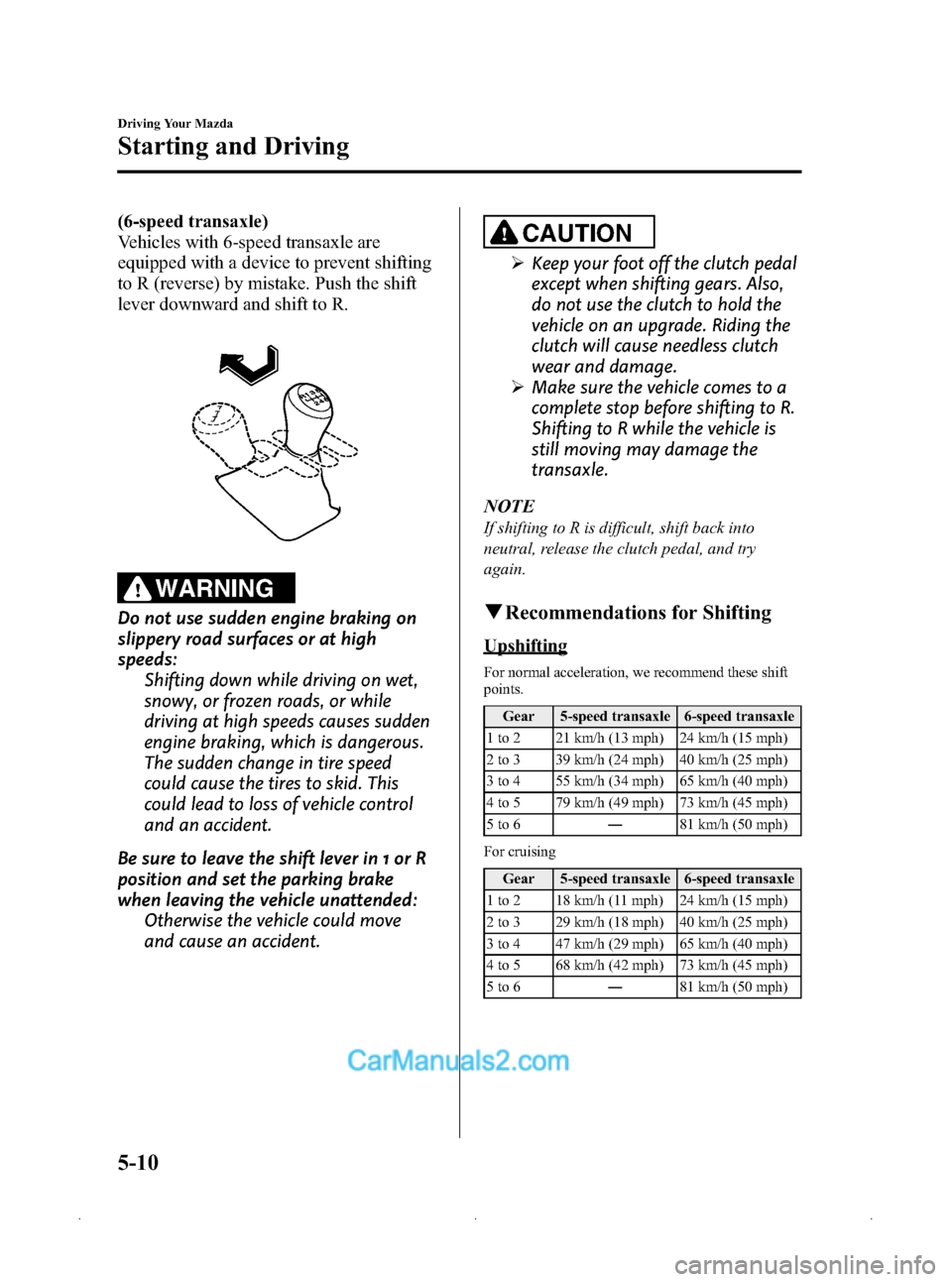
Black plate (132,1)
(6-speed transaxle)
Vehicles with 6-speed transaxle are
equipped with a device to prevent shifting
to R (reverse) by mistake. Push the shift
lever downward and shift to R.
WARNING
Do not use sudden engine braking on
slippery road surfaces or at high
speeds:Shifting down while driving on wet,
snowy, or frozen roads, or while
driving at high speeds causes sudden
engine braking, which is dangerous.
The sudden change in tire speed
could cause the tires to skid. This
could lead to loss of vehicle control
and an accident.
Be sure to leave the shift lever in 1 or R
position and set the parking brake
when leaving the vehicle unattended: Otherwise the vehicle could move
and cause an accident.
CAUTION
ØKeep your foot off the clutch pedal
except when shifting gears. Also,
do not use the clutch to hold the
vehicle on an upgrade. Riding the
clutch will cause needless clutch
wear and damage.
Ø Make sure the vehicle comes to a
complete stop before shifting to R.
Shifting to R while the vehicle is
still moving may damage the
transaxle.
NOTE
If shifting to R is difficult, shift back into
neutral, release the clutch pedal, and try
again.
q Recommendations for Shifting
Upshifting
For normal acceleration, we recommend these shift
points.
Gear 5-speed transaxle 6-speed transaxle
1 to 2 21 km/h (13 mph) 24 km/h (15 mph)
2 to 3 39 km/h (24 mph) 40 km/h (25 mph)
3 to 4 55 km/h (34 mph) 65 km/h (40 mph)
4 to 5 79 km/h (49 mph) 73 km/h (45 mph)
5to6 ―81 km/h (50 mph)
For cruising Gear 5-speed transaxle 6-speed transaxle
1 to 2 18 km/h (11 mph) 24 km/h (15 mph)
2 to 3 29 km/h (18 mph) 40 km/h (25 mph)
3 to 4 47 km/h (29 mph) 65 km/h (40 mph)
4 to 5 68 km/h (42 mph) 73 km/h (45 mph)
5to6 ―81 km/h (50 mph)
5-10
Driving Your Mazda
Starting and Driving
Mazda3_8Z87-EA-08F_Edition1 Page132
Monday, May 19 2008 9:57 AM
Form No.8Z87-EA-08F
Page 135 of 412
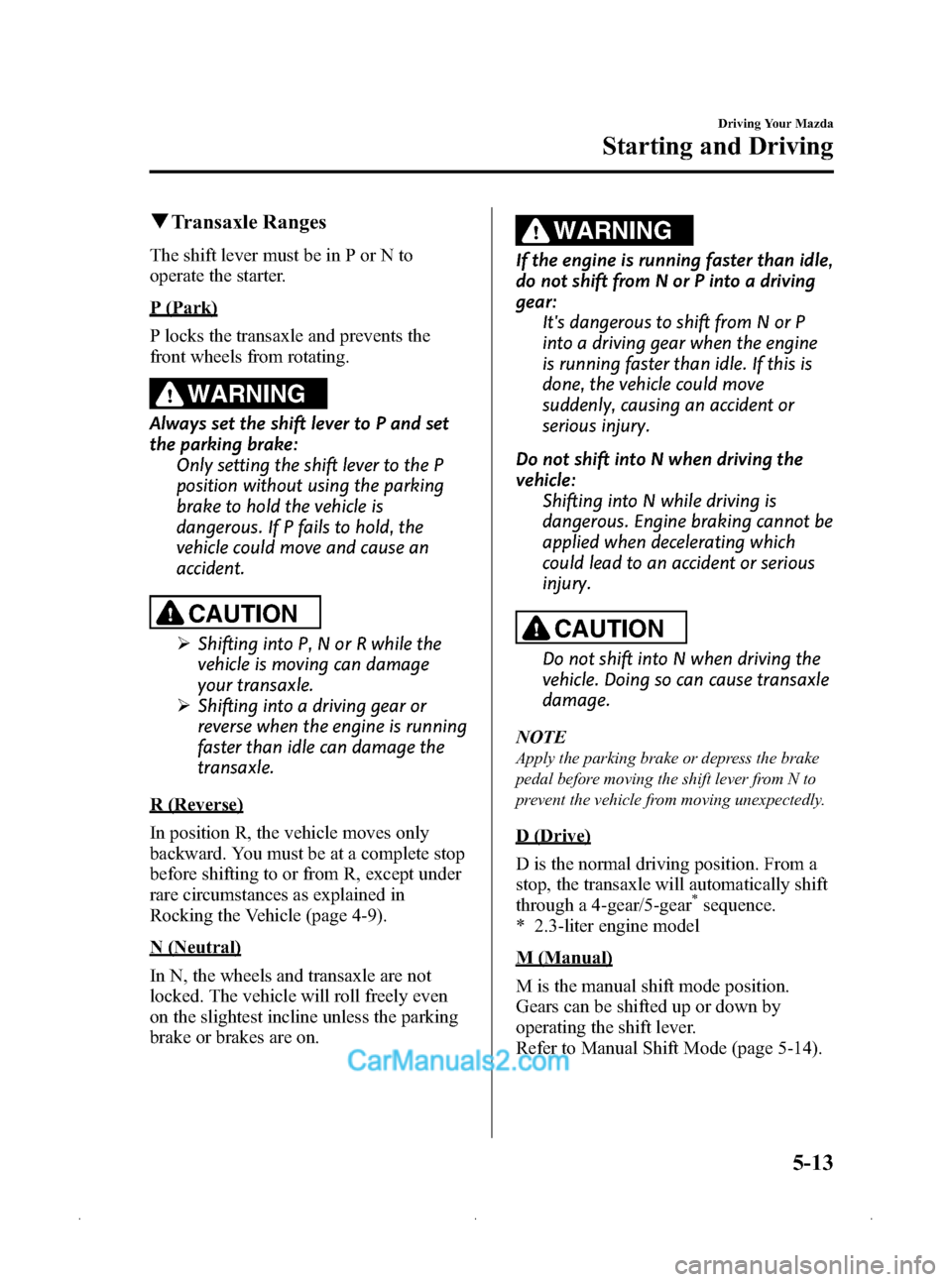
Black plate (135,1)
qTransaxle Ranges
The shift lever must be in P or N to
operate the starter.
P (Park)
P locks the transaxle and prevents the
front wheels from rotating.
WARNING
Always set the shift lever to P and set
the parking brake:
Only setting the shift lever to the P
position without using the parking
brake to hold the vehicle is
dangerous. If P fails to hold, the
vehicle could move and cause an
accident.
CAUTION
ØShifting into P, N or R while the
vehicle is moving can damage
your transaxle.
Ø Shifting into a driving gear or
reverse when the engine is running
faster than idle can damage the
transaxle.
R (Reverse)
In position R, the vehicle moves only
backward. You must be at a complete stop
before shifting to or from R, except under
rare circumstances as explained in
Rocking the Vehicle (page 4-9).
N (Neutral)
In N, the wheels and transaxle are not
locked. The vehicle will roll freely even
on the slightest incline unless the parking
brake or brakes are on.
WARNING
If the engine is running faster than idle,
do not shift from N or P into a driving
gear:
It's dangerous to shift from N or P
into a driving gear when the engine
is running faster than idle. If this is
done, the vehicle could move
suddenly, causing an accident or
serious injury.
Do not shift into N when driving the
vehicle: Shifting into N while driving is
dangerous. Engine braking cannot be
applied when decelerating which
could lead to an accident or serious
injury.
CAUTION
Do not shift into N when driving the
vehicle. Doing so can cause transaxle
damage.
NOTE
Apply the parking brake or depress the brake
pedal before moving the shift lever from N to
prevent the vehicle from moving unexpectedly.
D (Drive)
D is the normal driving position. From a
stop, the transaxle will automatically shift
through a 4-gear/5-gear
*sequence.
* 2.3-liter engine model
M (Manual)
M is the manual shift mode position.
Gears can be shifted up or down by
operating the shift lever.
Refer to Manual Shift Mode (page 5-14).
Driving Your Mazda
Starting and Driving
5-13
Mazda3_8Z87-EA-08F_Edition1 Page135
Monday, May 19 2008 9:57 AM
Form No.8Z87-EA-08F
Page 138 of 412
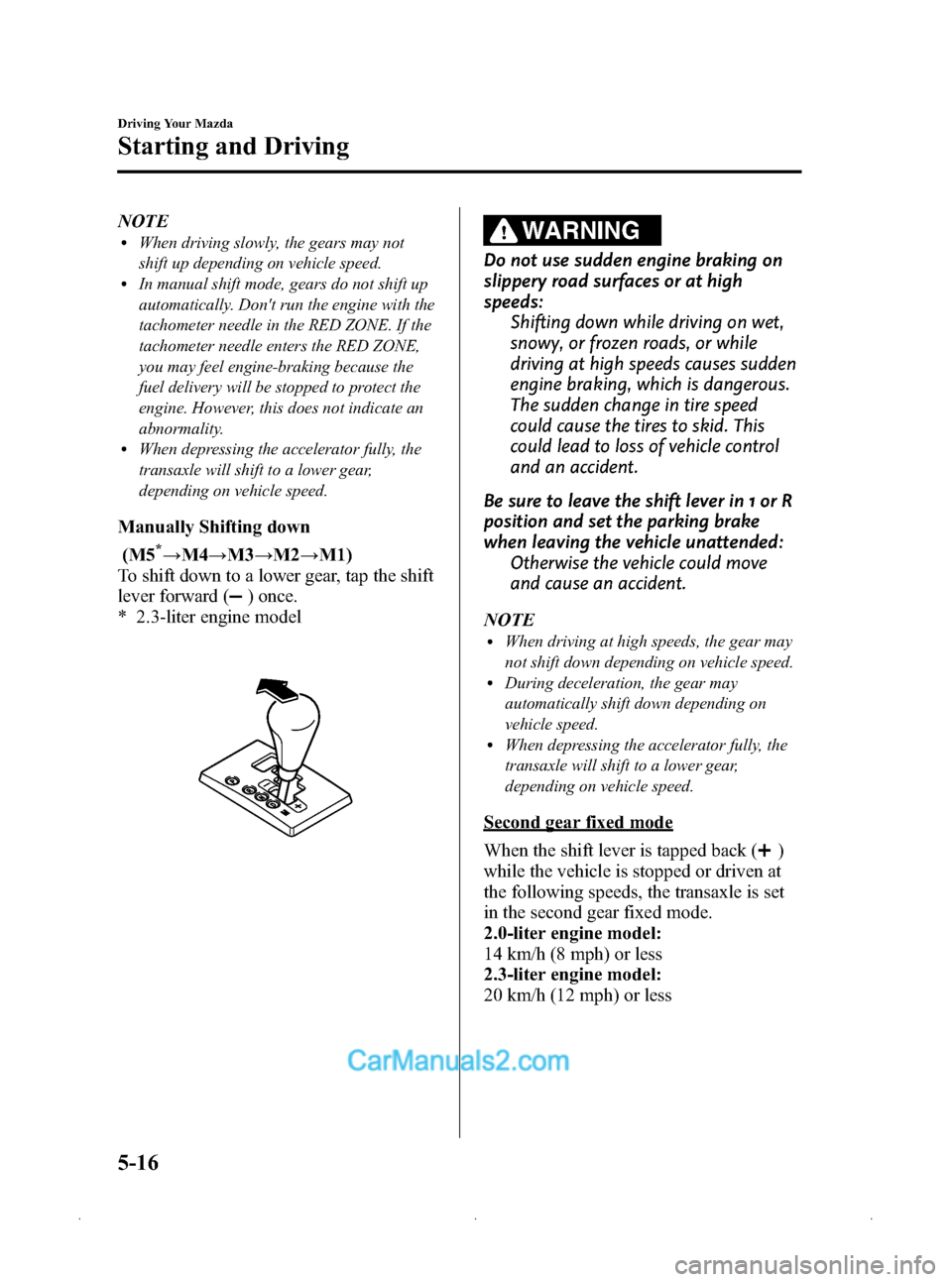
Black plate (138,1)
NOTElWhen driving slowly, the gears may not
shift up depending on vehicle speed.
lIn manual shift mode, gears do not shift up
automatically. Don't run the engine with the
tachometer needle in the RED ZONE. If the
tachometer needle enters the RED ZONE,
you may feel engine-braking because the
fuel delivery will be stopped to protect the
engine. However, this does not indicate an
abnormality.
lWhen depressing the accelerator fully, the
transaxle will shift to a lower gear,
depending on vehicle speed.
Manually Shifting down(M5
*→ M4 →M3 →M2 →M1)
To shift down to a lower gear, tap the shift
lever forward (
) once.
* 2.3-liter engine model
WARNING
Do not use sudden engine braking on
slippery road surfaces or at high
speeds: Shifting down while driving on wet,
snowy, or frozen roads, or while
driving at high speeds causes sudden
engine braking, which is dangerous.
The sudden change in tire speed
could cause the tires to skid. This
could lead to loss of vehicle control
and an accident.
Be sure to leave the shift lever in 1 or R
position and set the parking brake
when leaving the vehicle unattended: Otherwise the vehicle could move
and cause an accident.
NOTE
lWhen driving at high speeds, the gear may
not shift down depending on vehicle speed.
lDuring deceleration, the gear may
automatically shift down depending on
vehicle speed.
lWhen depressing the accelerator fully, the
transaxle will shift to a lower gear,
depending on vehicle speed.
Second gear fixed mode
When the shift lever is tapped back (
)
while the vehicle is stopped or driven at
the following speeds, the transaxle is set
in the second gear fixed mode.
2.0-liter engine model:
14 km/h (8 mph) or less
2.3-liter engine model:
20 km/h (12 mph) or less
5-16
Driving Your Mazda
Starting and Driving
Mazda3_8Z87-EA-08F_Edition1 Page138
Monday, May 19 2008 9:57 AM
Form No.8Z87-EA-08F
Page 142 of 412
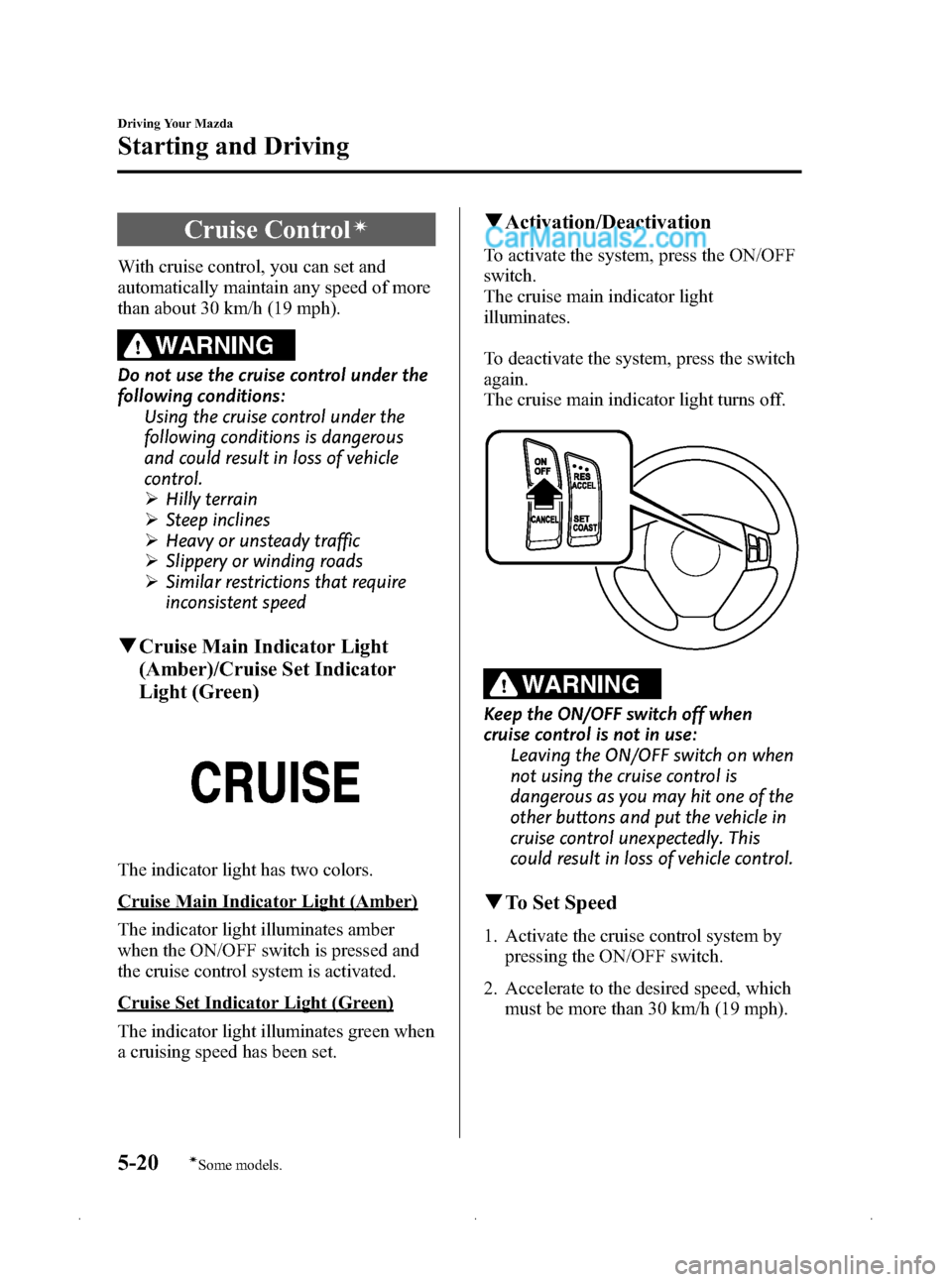
Black plate (142,1)
Cruise Controlí
With cruise control, you can set and
automatically maintain any speed of more
than about 30 km/h (19 mph).
WARNING
Do not use the cruise control under the
following conditions:Using the cruise control under the
following conditions is dangerous
and could result in loss of vehicle
control.
ØHilly terrain
Ø Steep inclines
Ø Heavy or unsteady traffic
Ø Slippery or winding roads
Ø Similar restrictions that require
inconsistent speed
qCruise Main Indicator Light
(Amber)/Cruise Set Indicator
Light (Green)
The indicator light has two colors.
Cruise Main Indicator Light (Amber)
The indicator light illuminates amber
when the ON/OFF switch is pressed and
the cruise control system is activated.
Cruise Set Indicator Light (Green)
The indicator light illuminates green when
a cruising speed has been set.
qActivation/Deactivation
To activate the system, press the ON/OFF
switch.
The cruise main indicator light
illuminates.
To deactivate the system, press the switch
again.
The cruise main indicator light turns off.
WARNING
Keep the ON/OFF switch off when
cruise control is not in use:
Leaving the ON/OFF switch on when
not using the cruise control is
dangerous as you may hit one of the
other buttons and put the vehicle in
cruise control unexpectedly. This
could result in loss of vehicle control.
qTo Set Speed
1. Activate the cruise control system by
pressing the ON/OFF switch.
2. Accelerate to the desired speed, which must be more than 30 km/h (19 mph).
5-20
Driving Your Mazda
íSome models.
Starting and Driving
Mazda3_8Z87-EA-08F_Edition1 Page142
Monday, May 19 2008 9:57 AM
Form No.8Z87-EA-08F
Page 145 of 412
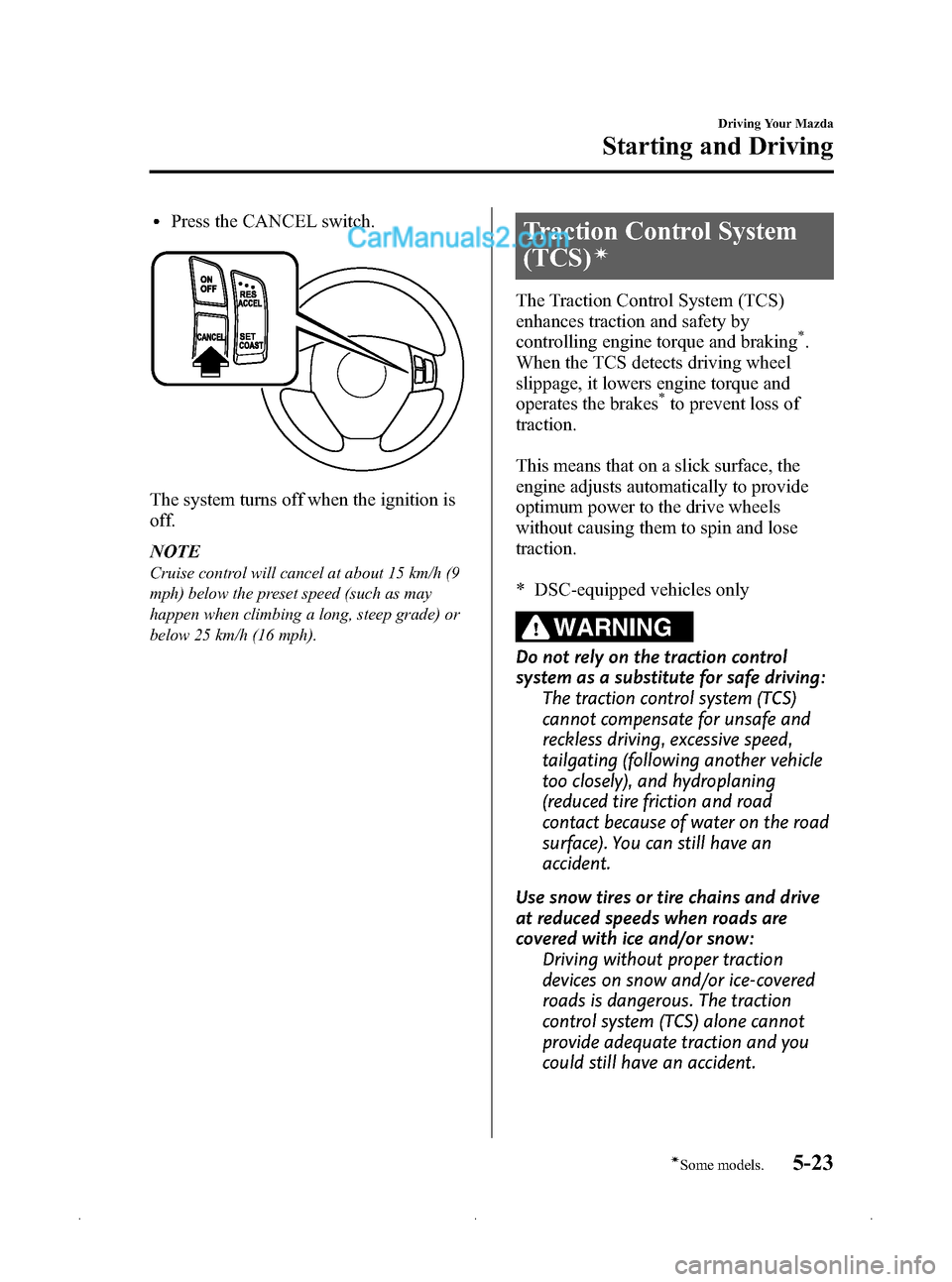
Black plate (145,1)
lPress the CANCEL switch.
The system turns off when the ignition is
off.
NOTE
Cruise control will cancel at about 15 km/h (9
mph) below the preset speed (such as may
happen when climbing a long, steep grade) or
below 25 km/h (16 mph).
Traction Control System
(TCS)
í
The Traction Control System (TCS)
enhances traction and safety by
controlling engine torque and braking
*.
When the TCS detects driving wheel
slippage, it lowers engine torque and
operates the brakes
*to prevent loss of
traction.
This means that on a slick surface, the
engine adjusts automatically to provide
optimum power to the drive wheels
without causing them to spin and lose
traction.
* DSC-equipped vehicles only
WARNING
Do not rely on the traction control
system as a substitute for safe driving: The traction control system (TCS)
cannot compensate for unsafe and
reckless driving, excessive speed,
tailgating (following another vehicle
too closely), and hydroplaning
(reduced tire friction and road
contact because of water on the road
surface). You can still have an
accident.
Use snow tires or tire chains and drive
at reduced speeds when roads are
covered with ice and/or snow: Driving without proper traction
devices on snow and/or ice-covered
roads is dangerous. The traction
control system (TCS) alone cannot
provide adequate traction and you
could still have an accident.
Driving Your Mazda
Starting and Driving
5-23íSome models.
Mazda3_8Z87-EA-08F_Edition1 Page145
Monday, May 19 2008 9:57 AM
Form No.8Z87-EA-08F
Page 146 of 412
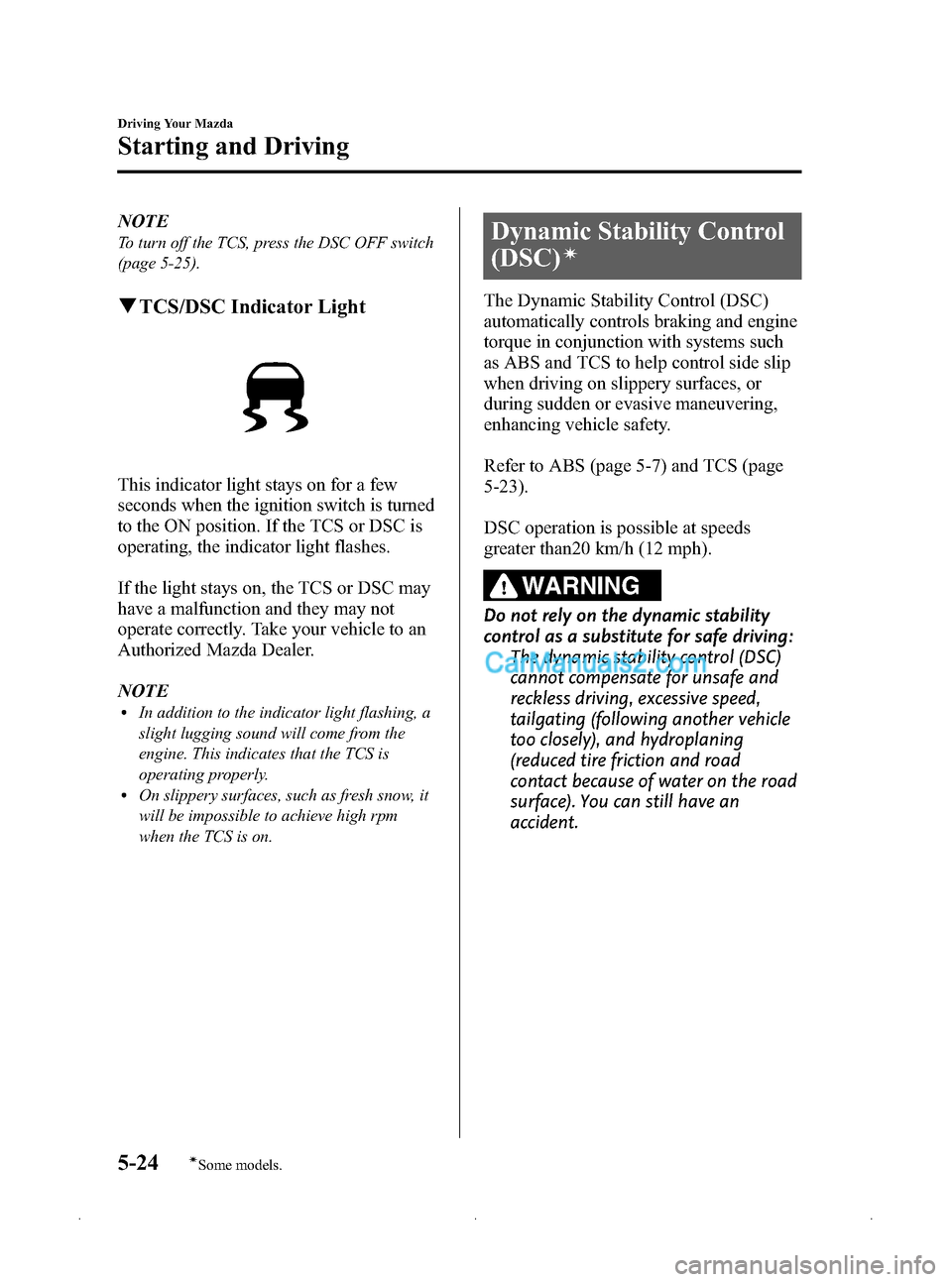
Black plate (146,1)
NOTE
To turn off the TCS, press the DSC OFF switch
(page 5-25).
qTCS/DSC Indicator Light
This indicator light stays on for a few
seconds when the ignition switch is turned
to the ON position. If the TCS or DSC is
operating, the indicator light flashes.
If the light stays on, the TCS or DSC may
have a malfunction and they may not
operate correctly. Take your vehicle to an
Authorized Mazda Dealer.
NOTE
lIn addition to the indicator light flashing, a
slight lugging sound will come from the
engine. This indicates that the TCS is
operating properly.
lOn slippery surfaces, such as fresh snow, it
will be impossible to achieve high rpm
when the TCS is on.
Dynamic Stability Control
(DSC)
í
The Dynamic Stability Control (DSC)
automatically controls braking and engine
torque in conjunction with systems such
as ABS and TCS to help control side slip
when driving on slippery surfaces, or
during sudden or evasive maneuvering,
enhancing vehicle safety.
Refer to ABS (page 5-7) and TCS (page
5-23).
DSC operation is possible at speeds
greater than20 km/h (12 mph).
WARNING
Do not rely on the dynamic stability
control as a substitute for safe driving:
The dynamic stability control (DSC)
cannot compensate for unsafe and
reckless driving, excessive speed,
tailgating (following another vehicle
too closely), and hydroplaning
(reduced tire friction and road
contact because of water on the road
surface). You can still have an
accident.
5-24
Driving Your Mazda
íSome models.
Starting and Driving
Mazda3_8Z87-EA-08F_Edition1 Page146
Monday, May 19 2008 9:57 AM
Form No.8Z87-EA-08F
Page 149 of 412
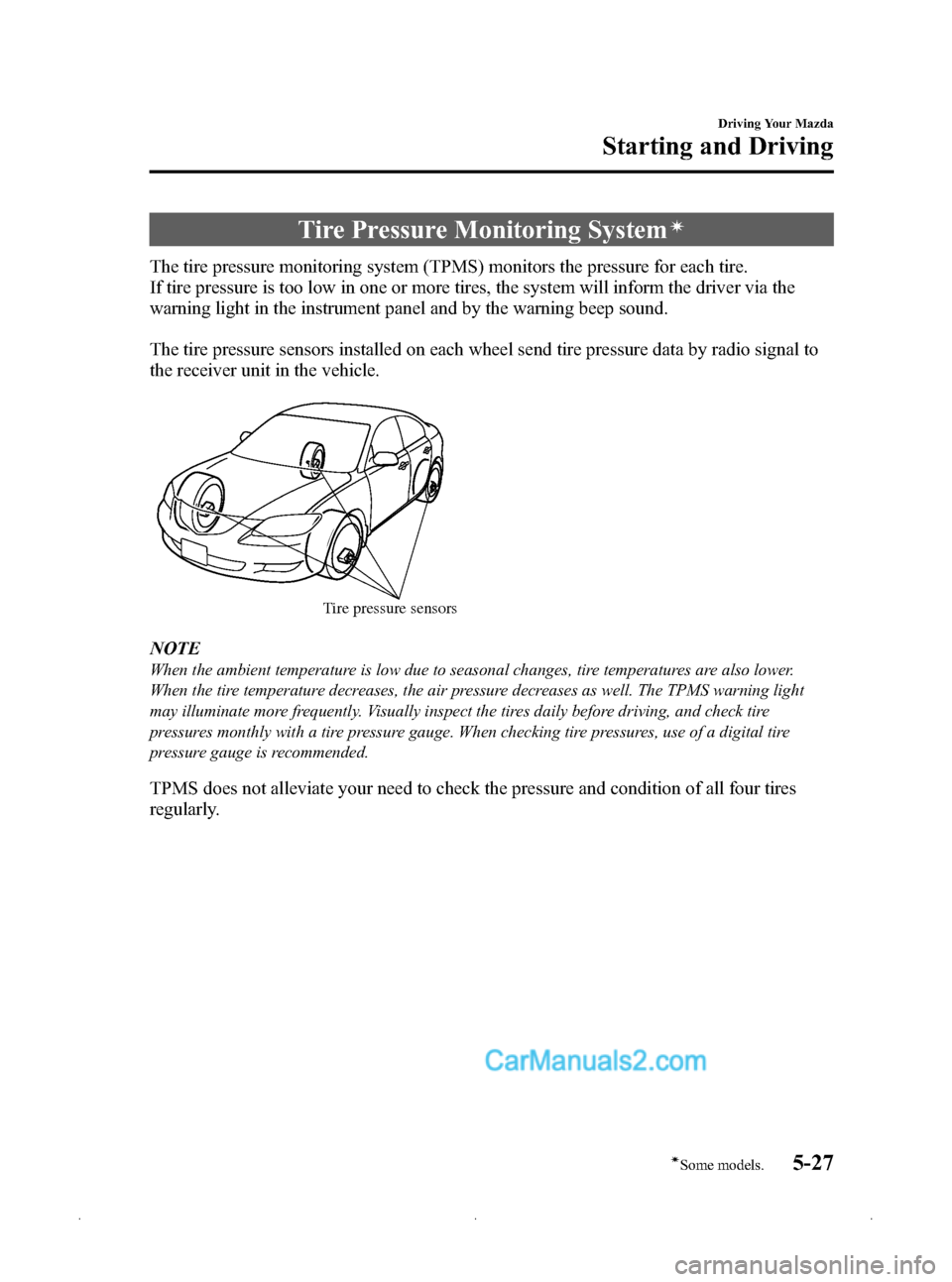
Black plate (149,1)
Tire Pressure Monitoring Systemí
The tire pressure monitoring system (TPMS) monitors the pressure for each tire.
If tire pressure is too low in one or more tires, the system will inform the driver via the
warning light in the instrument panel and by the warning beep sound.
The tire pressure sensors installed on each wheel send tire pressure data by radio signal to
the receiver unit in the vehicle.
Tire pressure sensors
NOTE
When the ambient temperature is low due to seasonal changes, tire temperatures are also lower.
When the tire temperature decreases, the air pressure decreases as well. The TPMS warning light
may illuminate more frequently. Visually inspect the tires daily before driving, and check tire
pressures monthly with a tire pressure gauge. When checking tire pressures, use of a digital tire
pressure gauge is recommended.
TPMS does not alleviate your need to check the pressure and condition of all four tires
regularly.
Driving Your Mazda
Starting and Driving
5-27íSome models.
Mazda3_8Z87-EA-08F_Edition1 Page149
Monday, May 19 2008 9:57 AM
Form No.8Z87-EA-08F